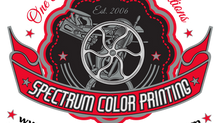Prepress Woes: Common File Issues for Printing & How to Resolve Them
Introduction
Common File Issues for Printing & How to Resolve Them Ensuring that your files are print-ready is crucial in the bustling world of printing. Prepress, the process of preparing digital files for printing, can be fraught with challenges that can delay production and increase costs. As a reputable printing company in Las Vegas, we at Spectrum Color Printing LLC Las Vegas understand the common prepress issues and how to resolve them effectively. This blog will explore these common file issues and offer practical solutions to ensure a smooth printing process.

Common Prepress File Issues
1. Incorrect File Formats
One of the most frequent issues in prepress is receiving files in incorrect formats. Printing companies typically require files in specific formats such as PDF, TIFF, or EPS. However, clients often submit files in formats like Word, PowerPoint, or JPEG, which are not ideal for high-quality printing.
Resolution:
Always check the file format requirements of your print shop in Las Vegas before submitting your files.
Use professional design software like Adobe InDesign, Illustrator, or Photoshop to create your print files and export them in the required formats.
If unsure, consult with your printing company to understand their preferred formats.
2. Low-Resolution Images
Low-resolution images can lead to pixelated and blurry prints, compromising the quality of the final product. The standard resolution for print is 300 dpi (dots per inch), but many files submitted are well below this threshold.
Resolution:
Ensure that all images in your file are at least 300 dpi.
Use high-resolution stock photos or professional photography to maintain quality.
Resample or replace low-resolution images with higher resolution versions.
3. Missing Fonts and Graphics
When fonts and graphics are not embedded in the file, it can lead to unexpected changes in the design. This issue often occurs when the printer does not have the same fonts installed as the ones used in the submitted file.
Resolution:
Embed all fonts and graphics in the final file.
Convert text to outlines or curves to avoid font issues.
Package your files, including fonts and linked graphics, if using software like Adobe InDesign.
4. Incorrect Color Modes
Printing typically requires files to be in CMYK (Cyan, Magenta, Yellow, Black) color mode, but many files are submitted in RGB (Red, Green, Blue) mode, which is used for digital screens. This mismatch can lead to color discrepancies in the printed product.
Resolution:
Convert your files to CMYK before submitting them to the printing company.
Use professional design software to accurately convert colors and preview how they will look when printed.
Consult with your Las Vegas print shop for color proofs to ensure color accuracy.
5. Bleed and Trim Issues
Bleed is the area of the artwork that extends beyond the trim edge, ensuring no white edges appear when the final piece is cut to size. Missing bleed can lead to unsightly white borders.
Resolution:
Include a bleed of at least 0.125 inches (3mm) around your artwork.
Set up your document correctly from the start with bleed guides.
Ensure important content is within the safe area, away from the trim line.
6. Incorrect Page Setup
Incorrect page setup can lead to alignment and sizing issues. This problem is common with multi-page documents like brochures and catalogs.
Resolution:
Set up your document size to match the final trim size.
Ensure margins, gutters, and columns are consistently set up across all pages.
Double-check page order and alignment before exporting the final file.
7. Overprinting Issues
Overprinting is a technique used in printing to overlap colors, but it can cause unwanted results if not used correctly. For instance, text set to overprint can disappear against a dark background.
Resolution:
Review and understand the overprinting settings in your design software.
Use overprint preview to check how overlapping elements will print.
Consult with your Las Vegas printing company if unsure about overprinting settings.
Tips for a Smooth Prepress Process
1. Communicate with Your Print Shop
Maintaining open communication with your print shop in Las Vegas can prevent many prepress issues. Discuss your project requirements, clarify doubts, and seek feedback on your files.
2. Proofread Thoroughly
Errors in text and design can be costly to fix once the printing process begins. Proofread your files meticulously before submission.
3. Use Preflight Tools
Preflight tools in design software help check for potential issues in your file before printing. These tools can identify problems with resolution, color modes, and missing fonts, allowing you to fix them beforehand.
4. Request Proofs
Requesting physical or digital proofs from your printing company can help you catch errors and make adjustments before the final print run. Proofs provide an accurate representation of the final product.
5. Stay Updated on Printing Standards
Keeping up-to-date with printing standards and best practices can help you prepare print-ready files efficiently. Attend workshops, read industry blogs, and consult with your print shop for the latest information.
Conclusion
Navigating the prepress process can be challenging, but understanding common file issues and how to resolve them can significantly streamline your printing projects. As a trusted Las Vegas print shop, we are here to help you every step of the way. By following the tips and solutions outlined in this blog, you can ensure that your files are print-ready, leading to high-quality results and timely deliveries.
Ready to start your next printing project? Contact our expert team at Spectrum Color Printing—Las Vegas for professional assistance and high-quality printing services. Let us help you bring your creative vision to life with precision and excellence.























Comments